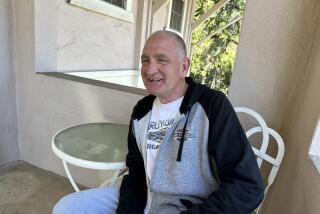Drug test breaks bonds with teen
Michael was 15. Tall, and soon to be taller, he ambled into my child-sized exam room and vaulted jauntily onto the table. He was followed by his mother, who, I noticed, had a worried look -- an expression not uncommon on parents of teens.
Before the physical examination, I explained how we would structure the visit: I would talk to and examine Michael alone, then meet with his mother to address her concerns.
To build trust, often a challenge, I usually start with the adolescent. Unlike many teens, Mike chatted comfortably about his health history. He had a new girlfriend but was not sexually active. School was going fine, he said, and alcohol, tobacco and drugs were not an issue.
MikeŌĆÖs mother, in the adjacent room, privately relayed to me a different story. Mike had always been an A and B student, but this year his report cards held Cs and Ds. Previously a grudging participant in family activities, Mike now spent hours away from home with friends his mother had never met. At home, Mike locked himself in his room, avoiding family. Sometimes he smelled of cigarettes. And, she added, perhaps marijuana.
She ended our discussion abruptly by asking that I test Mike for drugs.
I hesitated. At the time, around 1990, drug screening was becoming a popular tool for school administrators as well as employers. In the medical community, there were active discussions about privacy rights, and debates about what constituted consent and what was coercion. But policies and recommendations were not yet finalized.
Many adolescent specialists feared that forcing a teen to provide a urine sample, even at a parentŌĆÖs insistence, might damage the pediatrician-patient relationship. On the other hand, identifying a suspected drug problem might allow intervention and treatment that, in some cases, could be life saving.
Hoping to sidestep this ethical dilemma, I re-interviewed Mike alone. With his motherŌĆÖs permission, I relayed to him her concerns. Mike remained relaxed and friendly, insisting her suspicions were unfounded. His demeanor changed, however, when I brought up the possibility of a drug test. His smile faded and anger flashed in his eyes. Was this a sign that he was hiding something, or, as IŌĆÖd feared, justifiable anger at a perceived breach of trust?
Finally, at the urging of his mother -- and with MikeŌĆÖs reluctant acquiescence -- I ordered the urine drug screen. A week later, the day of their follow-up visit, the results arrived: positive for marijuana and cocaine.
I gently informed them of the findings. MikeŌĆÖs mother burst into tears; Mike retreated into a defensive silence.
I had called in a colleague who specialized in teen drug treatment, and she joined us to discuss therapeutic options and programs. At the end of the hour, Mike had begun to open up to the psychologist, but reserved only glares for me.
The American Academy of Pediatrics says more than 30% of adolescents have tried an illegal drug or inhalant by the eighth grade. More than half have used an illegal drug by the time they finish high school. I told myself that I had acted in MikeŌĆÖs best interest, and, in fact, the drug test had led him to treatment. I hoped that one day Mike would value the intervention.
But maybe I hadnŌĆÖt fully considered another course of action: bringing Mike back for a series of visits to build enough confidence between us that he might reveal the reason for his changes in behavior on his own.
A few years later, in 1996, the American Academy of Pediatrics Committee on Substance Abuse developed a position against involuntary drug testing of teens, even with parental consent, unless there are ŌĆ£strong medical or legal reasons.ŌĆØ
Coerced drug testing is still seen in many settings, however, such as school and athletic programs, where declining to be tested can result in exclusion from teams or other negative consequences.
Tests can be inaccurate, with false positives caused by ibuprofen, allergy medicines, poppy seeds or antibiotics. In addition, testing can further damage an already strained family situation. Teens who perceive drug tests as representing a lack of parental trust may become more rebellious. Intervention should be a partnership among teens, parents and doctors, not an intrusion that can drive teens further from resources they need.
The academy (in the journal Pediatrics, March 2005) identifies several behaviors that might signal drug use: changes in dress and grooming; changes in friends; loss of interest in activities; truancy or dropping grades; attempts at running away or suicide; the odor of alcohol or smoke on clothing or breath; or intoxication, dizziness or bizarre behavior.
Parents worried that their kids are using illegal substances often donŌĆÖt know where to turn for safe, confidential help. A first step can be talking to a family doctor or pediatrician. The doctor will interview the teen confidentially -- notifying parents, of course, if the teen risks harming himself or someone else. If there is detectable cause for concern, the doctor will work with families to find affordable inpatient or outpatient treatment.
About a year after first meeting with Mike, I spoke with his mother again. With outpatient therapy and the support of his family, Mike seemed to be staying drug-free. His report card showed a return to success, and his behavior at home had similarly improved. I was thrilled to hear of MikeŌĆÖs progress, but still wished I could have helped Mike and his family achieve those goals without the intrusion and disruption of that drug test.
Dr. Linda Reid Chassiakos is director of the Klotz Student Health Center at Cal State Northridge and a clinical assistant professor of pediatrics at UCLA.
More to Read
Sign up for Essential California
The most important California stories and recommendations in your inbox every morning.
You may occasionally receive promotional content from the Los Angeles Times.










